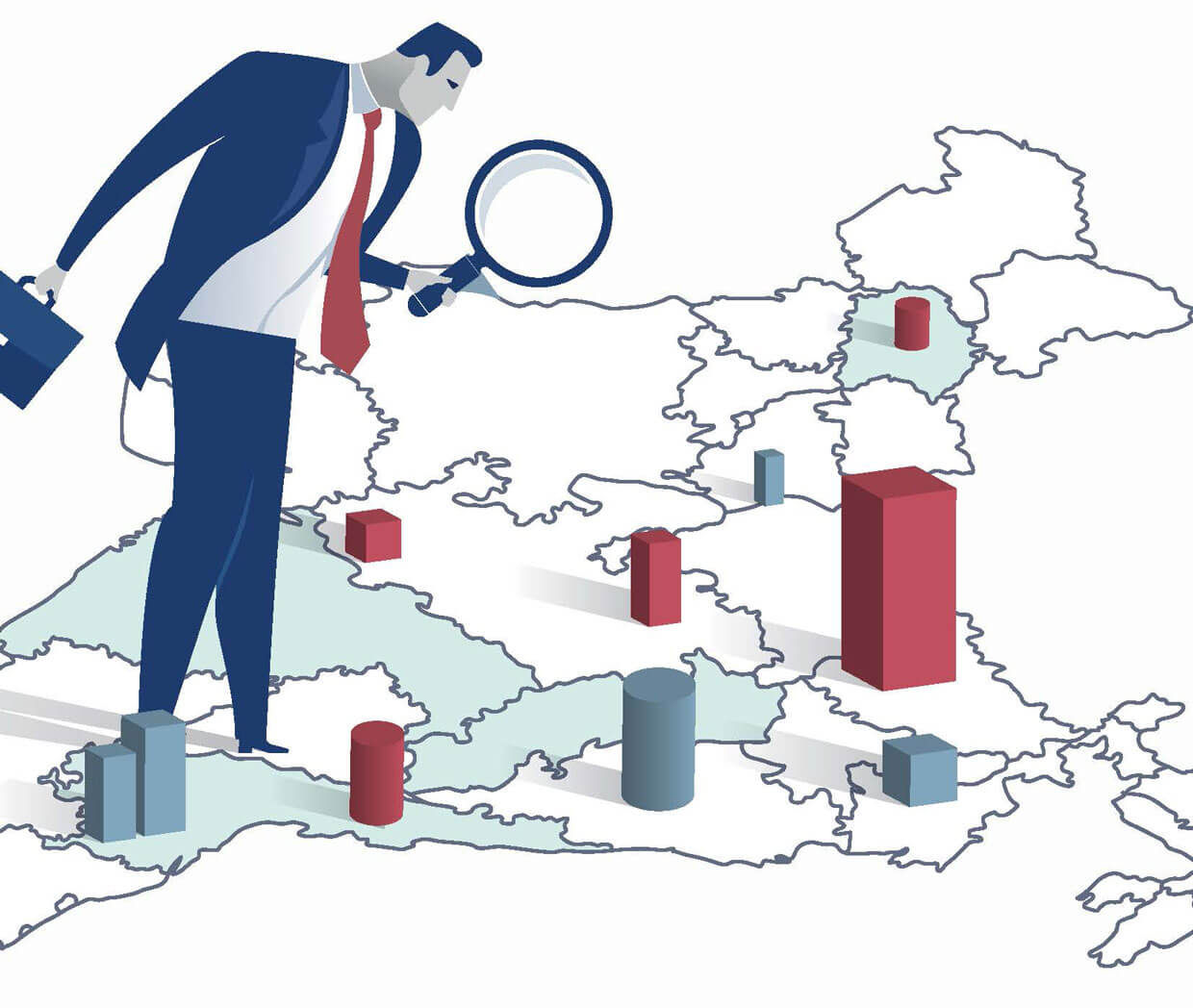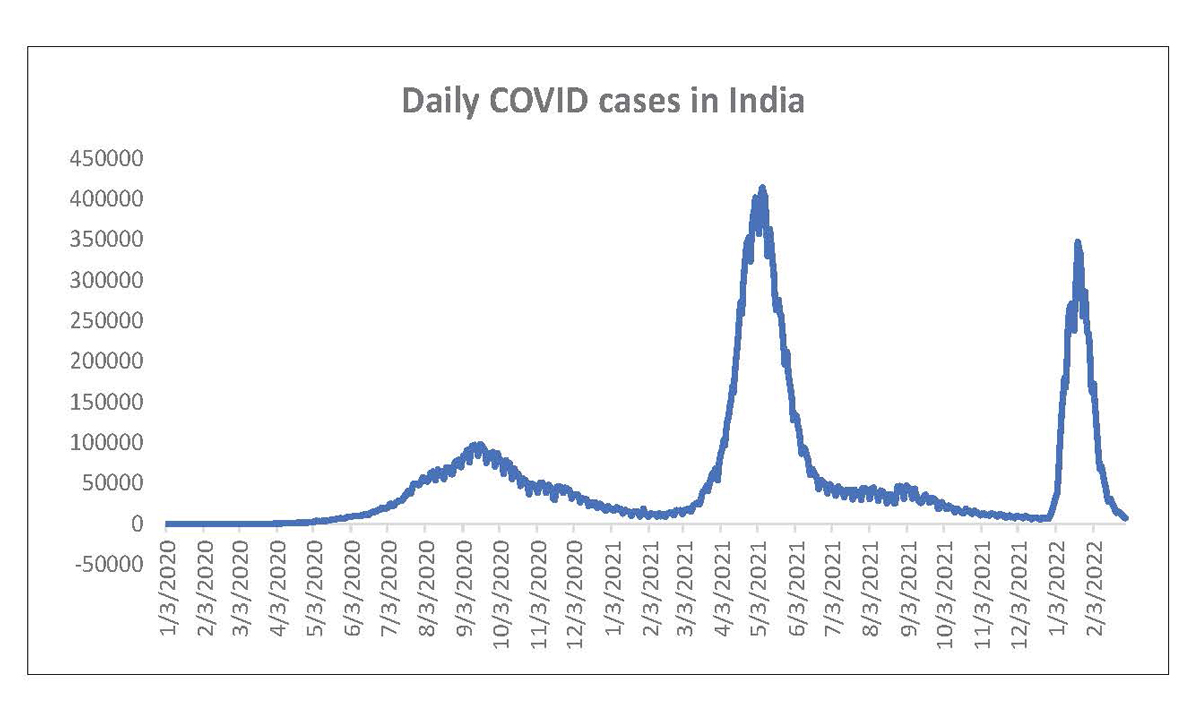
Macro and
Equity Market
Outlook
Equity Market
Outlook
Global Macro & Markets
February was gripped by weakness in sentiment
and spike in volatility mainly due to geopolitical
risks arising from Russia attacking its neighbor
Ukraine. MSCI world was down 2.7% dragged by
Euro-50 (-6%) and S&P500 (-3.1%). MOEX Russia
was down 30% over the month. MSCI EM lost 3.1%
whereby Hang Seng and NIFTY were down 4.6%
and 3.1% MoM respectively. Brent Crude stood to
be the biggest gainer of the crisis, crossing the
$100/bbl mark and gaining 10.7% over the month. It
has been the third consecutive month for 10%+
movement in Crude oil. LME Metals index also
gained 5.9% MoM. Bond yields remained flat with
US 10Y up 5bps to 1.82% while India 10Y 8bps up at
6.76%.
Domestic Macro & Markets
SENSEX declined 3% while broader market was even weaker as BSE
Midcap index and BSE Smallcap were down 5.1% and 8.8% MoM
respectively. Materials (+1.2%), Healthcare (-0.2%) and Staples
(-1.8%) outperformed the index while Communication Services
(-7.1%), Discretionary (-5.5%) and Financials (-5.4%) lagged the
most. Market breadth dipped in February with 35% of BSE 200 stocks
trading above their respective 200-day moving averages. FPIs sold
US$4.5 bn of Indian equities in the secondary market while DIIs
bought US$5.6 bn.

India's high frequency data update:
Positive momentum in GST collections, and steady growth in
manufacturing sector bodes well for quick recovery of the
economy after the mild disruption caused by spread of the
Omicron variant.
Manufacturing PMI:
Manufacturing PMI continued to remain expansionary at 54.9 in
February’22, quite better compared to 54 in January’22.
International demand rose at the quickest pace in three months,
though the increase was moderate.
GST Collection:
With collections at INR 1.33 Tn (+17.6% YoY) in February’22, collections
topped INR 1.3Tn mark for the fifth time now.
Power consumption:
Power consumption in the month of February’22 was 4.5% higher
than February’21 and 8.1% higher than the consumption in
February’20.
Core sector production:
Core sector production rose 3.7% YoY in January’22 as against a
YoY rise of 4.1% in December’21 and rise of 1.3% in January last year.
Industrial Production:
Manufacturing IIP declined 0.1% in December’21 vs growth of 2.3% in
December last year.
Credit growth:
Credit growth remained 7.9% YoY as of 11-Feb 2022 against YoY
growth of 6.6% as observed on 12-Feb 2021. Aggregate deposit
growth remained flat at 9.1% YoY.
Inflation:
CPI inflation in January’22 shot up to 6% from 5.66% on the back of
elevated fuel and light inflation (+33%) and core inflation (+6.2%).
WPI inflation moderated to 13%.
Trade Deficit:
December’22 trade deficit narrowed to US$17.8 bn as compared to
US$22 bn in December’21. Exports increased 25% YoY to US$34.5 bn
while imports increased by 24% YoY to $51.9 bn.
Balance of Payments (BOP):
Real GDP in 3QFY22 grew 5.4% as against the growth of 0.7% same
quarter last year and 8.5% in 2QFY22. Growth was majorly led by
private consumption growth of 7% (10.2% in 2QFY22). Government
consumption grew 3.4% (9.3% in 2QFY22), and investments (GFCF)
grew 2% (14.6% in 2QFY22).
Green Hydrogen Policy:
On February 17, the ministry of power unveiled India’s
much-awaited green hydrogen policy. The guidelines are a step in
the right direction to ensure that green hydrogen is used to
decarbonise and reduce emissions in the hard-to-abate sectors
like fertiliser manufacturing, oil refining and others. This mayalso
enable the government to meet its other objectives of energy
security, energy self-reliance, reducing imports of expensive fossil
fuels and thereby the import bill. It is also a huge opportunity to
build a new billion-dollar industry that may create jobs.
Market View
Near term market sentiment is likely to be influenced by the
increased geopolitical risks in the backdrop ongoing Russia-Ukraine
conflict, higher inflation/ commodity prices, rate hikes by Global
Central Banks and most importantly how these factors impact the
Global/domestic growth possibilities. Accordingly, we anticipate
higher than usual volatility or market swings in the short term.
From a domestic perspective while direct impact of
Russian-Ukraine conflict, through trade channel may be limited, the
indirect impact on Crude prices, Inflation, rising input or raw
material prices needs to be monitored. Notwithstanding the
short-term global risks and assuming that the geo-political
tensions are diffused soon, we remain optimistic on a reasonable
domestic recovery. Key drivers include relaxation of most COVID led
restrictions across states which may potentially spur demand,
anticipated revival in investment cycle & domestic manufacturing
etc.
Accordingly, we are attempting to maintain balanced portfolios
through a combination of domestic recovery themes along with
secular businesses. Given the external risks and its potential impact
we believe investing in a staggered manner or systematic route
may help iron out market extremes. Based on the prevailing
valuations diversified funds with allocations across market cap
range may be considered from a medium-term view. Conservative
investors seeking equity exposure with lower volatility may consider
asset allocation strategies like Balanced Advantage/Asset Allocator
which manage equity allocations dynamically.
Note: The sectors mentioned are not a recommendation to buy/sell in the
said sectors. The schemes may or may not have future
position in the said sectors. For complete details on Holdings & Sectors of NIMF
schemes, please visit website mf.nipponindiaim.com;
Past performance may or may not be sustained in future
Past performance may or may not be sustained in future
Chart of the month :
The economy has opened almost completely as daily COVID-19
cases have remained less than one lakh for 24 consecutive days.
Recovery has further improved to 98.6% and test positivity rate has
declined to below 1.5% and daily cases fell to nearly 20k.

Common Source:
WHO, Nippon India Mutual Fund Research, Bloomberg
Disclaimer:The information herein above is meant only for general
reading purposes and the views being expressed only
constitute opinions and therefore cannot be considered as guidelines, recommendations or
as a professional guide for
the readers. The document has been prepared on the basis of publicly available
information, internally developed data
and other sources believed to be reliable. The sponsors, the Investment Manager, the
Trustee or any of their directors,
employees, Associates or representatives (‘entities & their Associate”) do not assume
any responsibility for, or warrant the
accuracy, completeness, adequacy and reliability of such information. Recipients of this
information are advised to rely on
their own analysis, interpretations & investigations. Readers are also advised to seek
independent professional advice in
order to arrive at an informed investment decision. Entities & their associates
including persons involved in the preparation
or issuance of this material, shall not be liable in any way for any direct, indirect,
special, incidental, consequential, punitive
or exemplary damages, including on account of lost profits arising from the information
contained in this material.
Recipient alone shall be fully responsible for any decision taken on the basis of this
document.
